Bringing the Sculptures Back to Life
The restoration of the sculptures along the Central Corniche in Jeddah was an ambitious and demanding project. Plowden & Smith, a British company of some thirty skilled staff, has extensive experience of working in the region, in particular as part of the conservation, mounting and installation team for the opening of the Museum of Islamic Art in Qatar. The company was established in 1966, with Sotheby’s, the London Auctioneers, being one of our first clients. It was through Lina Lazaar in Sotheby’s Contemporary Art Department that I was invited, in June 2011, to meet Fady Jameel. He asked us to propose a comprehensive programme for the restoration and conservation of Jeddah’s remarkable sculptures. This was compiled with information and advice from as many of the artists’ studios or their foundations as we were able to identify.
It soon became clear that a combination of heat, sand, salt and humidity had caused the surfaces of the sculptures to deteriorate significantly since their original installation some thirty or more years earlier; there were also a few structural problems and some limited graffiti. Compared to sculptures similarly displayed in the UK, however, their condition was better than might have been expected.
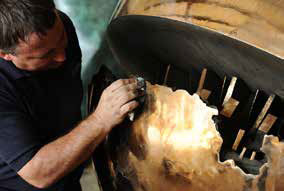
Restoration work on sculptures by Pomodoro and Moore
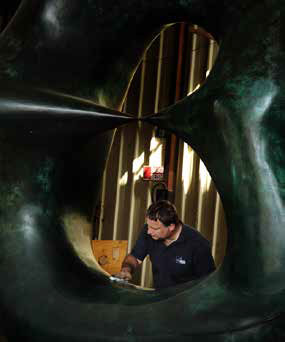
Adding a further layer of protective wax to Moore's Oval with Points
Through the assistance of Abdul Latif Jameel Community Initiatives (ALJCI), a workshop had been set up in Jeddah for the restoration work. Twenty-one bronze and steel sculptures were moved to the workshop where the restoration process was carried out; six other sculptures – because of their size or the work involved – were restored in situ on the Corniche. The removal of the sculptures was a journey of discovery. There was no available information about their weights or how they were held in position, so we had to hold each sculpture securely and protect it from damage, while we dug away the plinth and cut securing posts; invaluable assistance for this part of the project was provided by another British Company, Mtec Freight Group. Once released from its plinth, the sculpture had to be secured on a lorry for transportation back to the workshop, avoiding low bridges, overhanging trees and large potholes – a highly delicate manoeuvre!
Safely installed in the workshop, the condition of each sculpture was then assessed. The underlying principle when deciding on how to carry out the restoration was a desire to retain as much of the artist’s original work as possible, and to re-establish the artist’s vision or intention for the work. This was not always easy. The range of restoration work needed for each sculpture was as individual as the sculptures themselves, ranging from the rewelding of cracked joints, the replacement of missing or severely damaged sections, through to repolishing, repainting and repatinating (chemically colouring) the surfaces. The type of work required was generally dictated by the sculpture’s material, although no two procedures were the same.
The bronze sculptures – including works by Moore, Miró and Cherina – had built up a rough and dull surface patination that needed cleaning off. Bird guano had also etched into the surface in places. Once cleaned back and dried, the surface was treated with a combination of chemicals to re-establish the original patination. Some of the bronzes are a dark brown/black (for example Miró’s Project for a Monument), some a combination of different browns (Cherina’s Untitled), while others reveal a variety of greens (Moore’s Oval with Points). Bronze is an extraordinarily resilient material – as shown by discoveries of bronze tools dating to almost 5000 years ago. The patination (which in a sense is a controlled corrosion) produces a chemically stable surface that protects the object and reduces the rate of deterioration.
When it came to the steel sculptures, including works by Calder, Mazloum and Senbel, the most significant problem was corrosion damage: unlike bronze the soft and powdery corrosion (rust) that develops does nothing to prevent further deterioration (there are some modern ‘weathering steels’ that do develop a protective corrosion layer). In the past some repairs that had been made to these sculptures had also degraded, and the decision had to be made whether or not to remove and replace them.
In all cases the existing paint surface was not the original, so detailed investigation was needed to identify the colour schemes. With the Calder, for example, a paint had to be made up in the USA to the artist’s original specification, and although only two litres was needed, due to the shipping and customs requirements it took seven months to arrive. Two of the sculptures, Mazloum’s Balance and Abdulkarim’s Scrap Iron, presented a significant challenge: they had deteriorated too far to be restored to their original condition.
The sculpture by Mazloum, made up of mild steel sheets and installed in the late 1980s, occupied a position on the Corniche that made it accessible to the public; people would stand on the horizontal centre section and lean back on, and even run up, the slopes, causing significant deterioration. Many additional steel plates had been welded onto the original sculpture over the years, and it was clear that if they were removed there would be very little of the original material left. The strength of the internal support structure was also in doubt. Further damage and loss of original material would have occurred if the sculpture had been cut apart to examine and repair the internal supports. It was therefore decided that the best way to achieve the sculpture’s original shape and finish would be to produce an exact reproduction: an approach only used where the artist’s concept is clear, the manufacturing process can be replicated, and the original sculpture is damaged to the extent that the alternative would be to lose the work altogether. The work was carried out by a local metalwork company in Jeddah, and overseen by Plowden & Smith and a structural engineer. As a ‘memory’ of the original sculpture, the public information display plinth was constructed from two restored sections cut from the original sculpture.
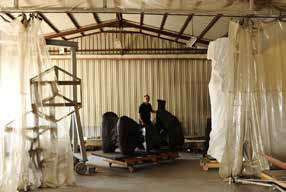
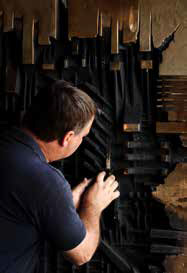
Repolishing elements of Pomodoro’s Cube IV
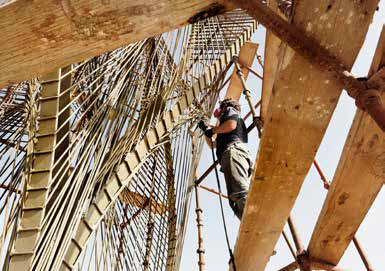
Priming Senbel’s Fisherman’s Net
Abdulkarim’s Scrap Iron is made up from assorted steel tools, gears and other parts of automotive machinery, welded together around a motorcycle frame. The resulting sculpture was reminiscent of a dog or wolf, with its head back, howling. From the restoration survey it was clear that the majority of the applied elements had been lost to rust and removal, and the structural frame had become unstable, leaving the sculpture bearing only a distant artistic relationship to its original form. The desire was to have it back on display on the Corniche. After weighing up various options, our recommendation was to make what was left of the original sculpture structurally sound and to chrome plate this frame to inhibit further corrosion – the result being essentially a new sculpture using the artist’s remaining material. This was ultimately felt to be too extreme and the sculpture remains in the workshop pending a decision on its treatment and future display (probably within a museum environment).
Working so closely with the sculptures allowed us to see them in much greater detail. We were able to view the inside structure of the large sculptures (for example Moore’s Large Spindle Piece, César’s Eye) and gain insights into the production process, identifying where individual cast sections are welded together, the presence of foundry marks (sometimes in chalk) numbering the sections, original foundry repairs, and so forth. Perhaps more intriguingly still, during the restoration process much has been learnt about the provenance and authorship of the sculptures: some pieces that were previously listed under ‘unknown artist’ have been conclusively reidentified as the work of such internationally significant sculptors as the Belgian François Kovacs and Italian Giò Pomodoro.
The restoration project was completed in August 2013 and the sculptures reinstalled in the new park area above the Hasan Anani Mosque in the Al Hamra district, creating the magnificent open air Sculpture Museum of internationally significant public art. Our hope is that the people of Jeddah will continue to enjoy these sculptures, which have been such a part of their lives and landscape, for many years to come.
Kevin Smith
Plowden & Smith